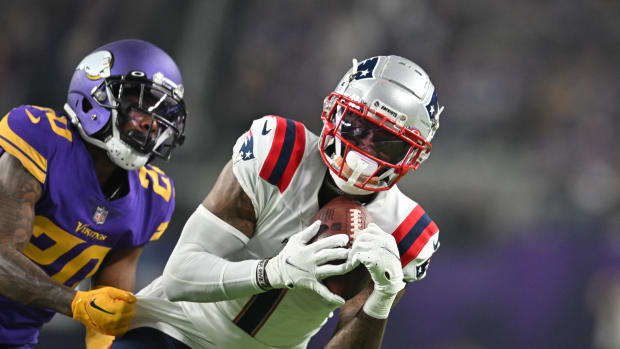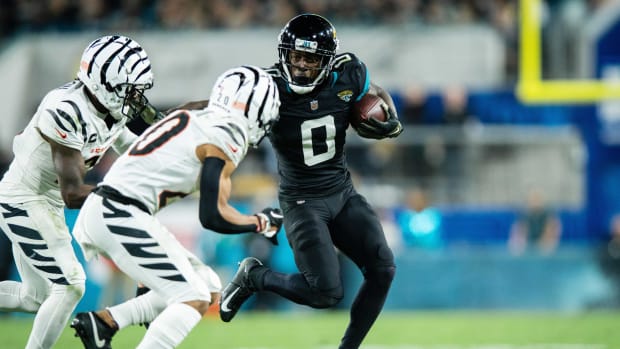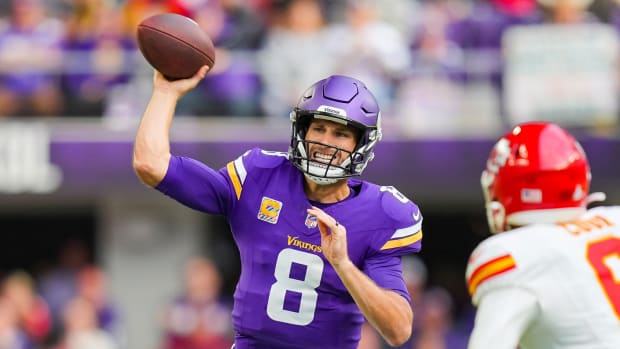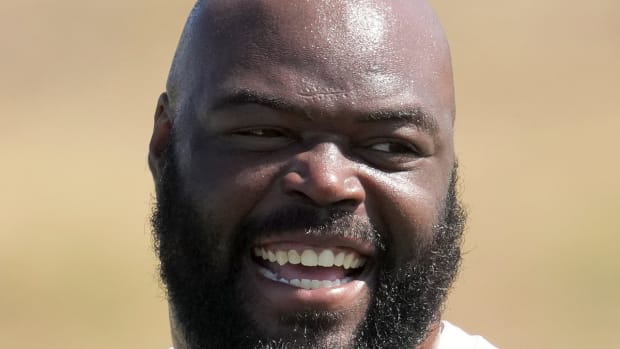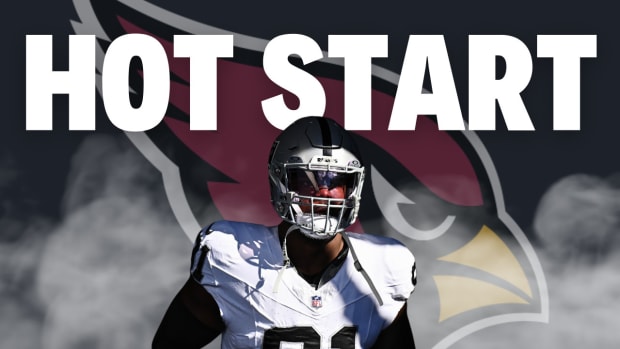Will NFL Broadcasts Ever Embrace Advanced Stats?
Once upon a time, back when Dan Marino and Joe Montana ruled the NFL, a book called The Hidden Game of Baseball highlighted a new metric called OPS (on-base plus slugging). It calculated the sum of a player's on-base percentage and slugging average. Today OPS is commonly discussed and displayed during game broadcasts of Major League Baseball. You are also starting to see other advanced statistics such as Wins Above Replacement (WAR) bubble to the surface of broadcasts. While MLB telecasts still revolve around the sport’s counting stats, there has been a clear embrace of sabermetrics and alternative statistics among a healthy group of the sport’s media (especially those in the digital space). It got me thinking: When will NFL broadcasts embrace football’s advanced stats?
The short answer, at least for the moment, is not anytime soon.
“With the speed of the game, it is hard enough to get in traditional statistics let alone something that will need a lot of setup and explanation," said Fred Gaudelli, the executive producer of NBC’s Sunday Night Football. “I think a studio-type show could explain a not-common statistic that might be relevant to a particular situation. But inside of a game, it is just hard to do. Take our audience, which is like 22 to 23 million people. How many of those people are really going to understand football at the level? If you are really going to get into these analytic statistics inside a game, you are going to be speaking a foreign language to people."
What Ails RG3
Is it the ankle? The knee? Or an Achilles’ heel: his inability to operate from the pocket? The MMQB’s film-study guru says physical setbacks can’t explain away Robert Griffin III’s poor grasp of quarterbacking basics.
FULL STORY
One of the foremost members of the advanced football stats community is
, the editor-in-chief of
. Schatz believes part of the reason NFL viewers have not seen advanced football stats—such as
on his site—in broadcasts is
because objective analysis in football is still in an infancy stage compared to baseball.
“It's a lot more recent, which means a lot less time for stats to develop and spread to the public," Schatz said. “It also means fewer people who are conversant in those stats and the ideas behind them. I'm not talking here about whether people understand advanced stats, but rather whether people would even have it in their general toolbox of ideas to think, Oh, I wonder what Advanced Football Analytics thinks about this fourth-down decision? Or, We're going to talk about Seattle's offensive line; how are they doing in Adjusted Line Yards or Adjusted Sack Rate? In some ways, this is tied to what I feel is a general problem with NFL commentary on television. I've often said that when I started Football Outsiders [in 2003], my goal was never a revolution in how football teams were run. It was a revolution in the way football was covered by the press—the death of stupid, meaningless, and often flat-out wrong clichés.”
While some of the conventional stats are being pushed aside for more second-level ones on broadcasts, Schatz still sees plenty of room for improvement.
“I do think you are seeing more of the charting-style stats—and more 'splits' such as 'how this quarterback performs outside the pocket compared to inside the pocket'—and you'll continue to see more of those stats,” Schatz said. “But as far as advanced ratings like Football Outsiders DVOA, I'm not sure of a better setup for advanced stats than ESPN creating Total QBR and broadcasting Monday Night Football, and yet Total QBR is not on Monday Night Football. So I don't see CBS or Fox using stats from Football Outsiders or Pro Football Focus on a regular basis any time soon.” (Interestingly, Sunday Night Football analyst Cris Collinworth became a part owner of PFF this summer.)
"[Broadcasting advanced stats] would really completely blow up a lot of clichés and a lot of the typical commentary," Schatz says, "because the numbers would tell such a different story than the predetermined narrative."
ESPN’s Jeff Bennett is more of an optimist. For two decades he has worked in ESPN’s statistical department and is now the senior director of ESPN Stats & Analytics. Bennett believes as the NFL continues to invest in player tracking devices (such as chips in players’ shoulder pads to monitor movement and speed), they’ll be adding objective data to help support or refute what the analysts are saying. Fox Sports producer John Entz echoed similar thoughts. “You hear much more about advanced statistics in baseball because that’s how many, if not most, MLB teams are evaluating their players," Entz said. “If NFL teams start to use these statistics the way that MLB teams do, we’ll have no choice but to follow their lead."
What advanced stats would benefit NFL game broadcasts? Bennett said win expectancy or a probability model would benefit NFL viewers (i.e. what are each team’s chances of winning at a given time) during a game broadcast. He also had a response for why QBR is not used on Monday Night Football.
“We feel very confident that QBR is the most complete picture of a quarterback’s performance because it is not just passing; [QBR] is also off of running, taking sacks, avoiding sacks, fumbles, and certain types of penalties that either penalize or reward the QB,” Bennett said. “It is much more detailed than NFL passer rating, and it has context to the game. Where it gets complex is we are dividing credit on every play for a quarterback. We look at yards after catch and how far the ball travels in the air. Was it a rush? Was it an overthrow? Was it a scramble? Was it a drop? The aggregation of statistics that we do—and right now we are doing it off broadcast video, and we have three trackers for every game and use objective criteria—is something we cannot turn around in real time for every game. Even if we wanted it only for Monday Night Football, we would be behind. But we might be moving down this road with what the NFL is doing with next-gen stats, with chips in the players’ shoulder pads. There could be the creation of a QBR in real time that would add value to a broadcast.”
Bennett said QBR would have major value in pre-game storytelling, and the one thing everyone I spoke with agreed on was that studio shows would be the place to start if football-airing outlets were willing to cede airtime from ex-players and coaches to a stats expert.
“First, it's important to note that there are two kinds of advanced stats," Schatz said. “You have the math-influenced stats that use regression analysis and data modeling to do things like analyze probabilities and project future performance. This includes stuff like ESPN's Total QBR, DVOA and Adjusted Line Yards. That’s a lot of the stats we're known for at Football Outsiders; the win probability analysis that Brian Burke does at Advanced Football Analytics; and the run/pass game script analysis that Chase Stuart does at Football Perspective.
Inside Replay Command
The NFL’s new New York-based replay process is supposed to make calls faster, more accurate and more consistent. Peter King went behind the scenes to see if the system is working as intended.
FULL STORY
"On the other hand you have stats created from charting games and marking information not normally found in play-by-play: Broken tackles, formations, defensive coverage, blown blocks and so on. There are three major groups doing this: Stats Inc., Pro Football Focus and ESPN Stats & Information/Football Outsiders. (Schatz said his site starts with ESPN charting, then adds some of its own.)
“So each category of stats presents its own problems. The math-influenced stuff can be hard for average fans to understand, especially without some kind of explanation, although I think that the win probability analysis is an exception there. The charting stats are somewhat subjective and inconsistent between organizations. Stats Inc. will have one count of sacks allowed by an offensive lineman, PFF another, and we'll have a third, because of subjectivity, and we're probably all using slightly different definitions. But both categories of stats present a problem because these stats are almost all proprietary. It's not like OPS, where it's just, Hey, instead of using batting average, use slugging percentage and on-base, and even better, add them together! Things are way more complex than that."
Something Schatz said during our interview stood out for me. He said what would really benefit NFL viewers was to have commentators who are conversant in the ideas behind the advanced stats movement. Some examples: "rate" stats being more informative than "total" stats; teams needing to go for it on fourth down more; passing generally being more efficient than rushing; and large individual rushing totals often being the result of running out the clock in a victory.
“The issue is not getting advanced stats onto game broadcasts. It’s getting the ideas behind advanced stats onto game broadcasts.”
“The one bit of advanced analysis I think would be most useful during a game broadcast would be a win expectancy model,” Schatz said. “That would be extremely valuable during games. When a coach has to decide to go for it or not, show the numbers. When a coach has to decide to kick away or onside kick when losing late in the game, show the numbers. But this would really completely blow up a lot of clichés and a lot of the typical commentary, because the numbers would tell such a different story than the predetermined narrative.
“That idea gets to my strongest point about advanced stats on football game broadcasts, which is that the issue is not getting advanced stats onto game broadcasts. The issue is getting the ideas behind advanced stats onto game broadcasts. I actually don't think that advanced stats get used much on baseball or basketball broadcasts either, but the ideas are there. We all understand now that three-point shots are more efficient than long twos. We all understand the value of walks in baseball.”
Follow The MMQB on Facebook, Twitter and Instagram.
[widget widget_name="SI Newsletter Widget”]




































